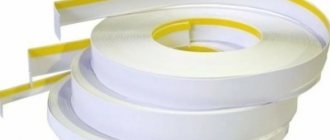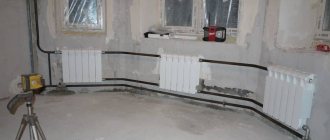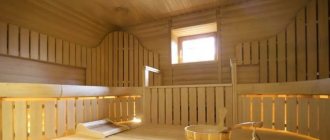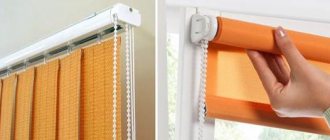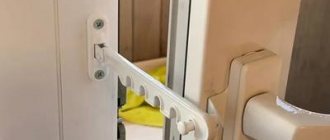An integral part of arranging an autonomous heating system for a private home is the installation of batteries. However, in order for their operation to be durable, trouble-free and provide comfortable living, it is necessary to take into account several important nuances. Let's look at what SNiP requirements the installation of heating radiators must comply with, what are the main criteria for choosing devices, how to correctly determine the location for their installation and the method of connection, what are their main varieties and what are their features, as well as what stages the installation procedure consists of.
Heating radiator under the window Source srubdacha.ru
Installation of heating radiators - SNiP requirements
In order for the heating device to produce the properties specified by the manufacturer during operation and successfully cope with its function, a number of SNiP requirements must be taken into account when installing it:
- Installation of heating radiators must be carried out with a gap to surrounding objects and structures - at least 3-5 cm to the wall, at least 5 cm to the window sill strip, and from 7 to 15 cm to the floor surface.
- The length of the device body should be from 50 to 75% of the width of the window opening under which it is located.
- To ensure better circulation of heated air, the radiator is installed next to the doors or window.
- The optimal placement of the device relative to the window is in the center. A deviation of 2-3 cm is allowed.
Advice! Shielding the area of insufficient wall thickness next to which the radiator is installed with foil-coated thermal insulation material can reduce the heat loss of the device by 10-15%. However, such protection should not be installed in all cases. For example, heating the wall under the window sill allows you to avoid the accumulation of dampness near the window.
Installing a radiator in a niche Source santex-tomsk.ru
Criteria for choosing a radiator - technical parameters, types
Despite the fact that the main selection criteria are appearance, compliance with the interior and cost, without taking into account technical parameters, correct, trouble-free and durable operation of devices is almost impossible. Therefore, in addition to the type of material and design features, it is important to take into account the technical characteristics of the device.
Options
In order to correctly assemble and install heating radiators, you must first understand their basic technical characteristics:
- System pressure. The materials and design of the device must be designed not only for the operating pressure, but also for possible water hammer. For autonomous systems, its value, as a rule, does not exceed 2-4 atm.
- Heating level. The temperature of the coolant leaving the boiler circuit should not exceed the permissible heating level of the battery. Otherwise, this will lead to deformation of the seals and distortion of the housing itself, which can lead to depressurization and leakage. For private systems, its value usually does not exceed 900C.
The use of thermal heads allows you to control the heating level of the battery Source otoplenieblog.ru
- Coolant purity level. Various suspensions and dissolved substances present in the coolant, when heated/cooled, can settle on the walls of radiators, narrowing their clearance and reducing heat transfer. Over time, this will lead to excessive consumption of coolant, overloading the pump and the need to replace devices.
Important! Often, when designing a house, special niches are placed in the walls into which heating radiators can be hung, but such a design must be created correctly from the beginning. This is not only the dimensions and depth of the excavation, but also the sufficient thickness of the partition, facing the other side onto the street, in order to avoid significant heat loss and excessive consumption of energy resources.
Varieties
When choosing radiators, the material of its body and design features are also taken into account. Based on this feature, they are divided into 6 main varieties:
- Aluminum sectional. Made from an alloy of aluminum and silicon. They are distinguished by their light weight, aesthetics, maximum heat transfer and heat resistance. However, they are sensitive to water hammer and the composition of the coolant.
Aluminum sectional radiators of different heights Source googleapis.com
See also: https://m-strana.ru/services/inzhenernye-sistemy-otoplenie-vodosnabzhenie-kanalizatsiya/
- Bimetallic with a silumin body and a steel base - sectional and monolithic. Heat transfer is close to aluminum analogues. Quite expensive products.
- Steel panel and tubular. They are universal in use, but are not as durable as their cast iron counterparts; in addition, they are characterized by insufficient heat transfer.
- Cast iron sectional. They are characterized by low cost, durability, strength, durability and inertia. Disadvantages: heavy weight, cumbersome.
- Copper. Suitable for installation and operation in any conditions. The downside is the very high cost.
- Plastic. Applicable for systems with low pressure and stable operation when heated to no higher than 800C.
The most popular are aluminum radiators; they are lightweight, quickly transfer heat and are durable - they are assembled from silumin sectors - however, installation in an autonomous heating system requires strict control of parameters. This is primarily the operating pressure, pH level and degree of purity of the coolant. Otherwise, the device body quickly corrodes, deforms, cracks and fails.
Aluminum radiators will easily fit into any interior of a modern home Source teplosfera31.ru
Fasteners for steel heating devices
There are two different types in this group: tubular and panel radiators. They have different designs and, accordingly, different fastenings.
In panel radiators, brackets are welded on the rear wall, with the help of which they are hung on brackets. The shape of this type of fastener is different: it is designed specifically for staples.
In panel radiators, brackets are welded on the rear wall
When installing panel radiators, it is necessary to strictly monitor the vertical position of the brackets. High precision required: four or six staples must fit exactly onto the hooks
It is also important that the wall is perfectly flat and smooth. In general, using conventional brackets, panel radiators are quite difficult to hang
It is easier to work with other types of holders.
Standard bracket for panel radiator
Since the mass of the heating device is small, it is quite enough to fix it on the upper brackets and install stops at the bottom that will give it direction in the horizontal plane. They are not attached to the wall, but are hooked onto a bracket and simply rest against the wall. For reliability, the part that faces the wall is expanded.
This is what a set of brackets for tubular steel batteries looks like: the upper collector is hung on the hooks, and plastic stops are placed below
There are also special mounting strips for easy installation. They are a strip of metal with plastic clips at the top and bottom. When using this fastener, there is no need for brackets on the rear panel. The slats are fixed to the wall, a radiator is inserted into them, which is held in place by plastic hooks.
Rail for quick installation of panel batteries
Fasteners for tubular radiators are similar to sectional ones: the same hooks, only of a different size, often equipped with plastic covers.
There is also a special fastener with SMB tube grips. This is a strip of steel with plastic clips and a shelf at the bottom that serves as a support for the radiator. This mounting plate can be used if the weight of the device filled with water does not exceed 100 kg. Installation is simple: place the battery on the shelf, bring the top edge closer to the latches. They grab the nearest tube and a click is heard. The radiator is installed, the supply pipes can be connected.
Bar for quick installation of a tubular radiator with shelf and clamps
There is a second option for quick installation: SVD fasteners. It consists of two parts. One is attached to the radiator, the second to the wall. Then they are connected to each other and secured with a steel loop.
Another type of holder for tubular models: two parts, one is attached to the wall, the second is attached to the pipe. They are held together with a wire fastener.
Floor mounting for tubular radiators can be of several types: tubular supports that are welded at the factory, or stands with hooks. Radiators are hung on such racks, and the racks themselves are attached to the floor.
https://youtube.com/watch?v=VkAVZDnvz6w
Brackets for radiators are of different types and types: for wall and floor installation. The standard ones that come with the kit are reliable, but they are more difficult to work with. Planks and devices for quick installation save time, but cost a lot.
Installation locations and connection methods
Due to the fact that the main purpose of heating devices is to minimize the influence of weather conditions on the microclimate of the room, they are installed in the following places where heat is most likely to leak:
- In the window sill area.
- The space between window openings.
- Walls of corner rooms.
- Hallways, corridors.
- Solid walls inside bathrooms, showers, storage rooms and utility rooms.
The rules for wiring a radiator during installation in a heating system are determined by the type of its assembly - there are the following three options:
- Single-pipe. The coolant passes through the system using one pipe - sequentially passing through all the devices and returning back to the heating circuit. The advantage is a simple device, the disadvantage is that subsequent batteries receive less heat than the previous ones.
- Two-pipe. There are two parallel highways - forward and reverse. Radiators are connected to both of them and receive the same amount of heat regardless of the distance in the circuit.
- Collector. The system involves connecting separate lines to each device.
Diagonal method of connecting a radiator Source sjthemes.com
Modern heating batteries, depending on operating conditions, can be connected in the following different ways:
- Lateral or one-sided. The supply line is connected to the top input, the return line is connected to the bottom of the same side. The method is characterized by a high degree of heat transfer. The scheme is applicable when the devices are at a short distance from the boiler, as well as in powerful systems. On the contrary, with a large distance and low pressure, the coolant will not warm up most of the radiator sections.
- Diagonal. The direct supply pipe is connected to the top of the radiator on one side, the return pipe to the lower outlet on the other. The method is applicable to devices with a long body and is one of the most effective. It is also used to connect batteries in weak systems.
- The bottom is double sided. Both lines - inlet and outlet - are connected to the lower pipes, but on opposite sides. This option is convenient when the coolant pipeline is installed in the floor. However, the efficiency of this method is minimal and heat loss is the greatest - up to 15%.
Recommendations
Replacing heating elements yourself is often associated with a number of mistakes. How to avoid them and ensure high heat transfer of the system is indicated in the following recommendations:
- strong fastening of batteries is the key to long-term operation, therefore there should be no less than three fixation points;
- ensuring the correct horizontal level will eliminate the formation of “air jams”;
- regardless of the location of windows in corner apartments, all walls bordering the street must be equipped with radiators;
- creating a reflective screen on the wall side in the plane of the heating element will increase the useful thermal output;
- in a single-pipe wiring diagram, a bypass is installed between the pipes, in the form of a jumper between the inlet and outlet of the coolant, which will allow replacement or repair without shutting down the entire system;
- to calculate the number of heaters, taking into account that the formulas include a significant number of coefficients, it is better to use calculators on construction sites or contact specialists;
- In order to avoid conflicts with the management company when replacing central heating elements in an apartment, actions must be approved in the manner established by the collective agreement.
DIY installation diagram
Even with completely correct installation of heating elements, owners can violate the heating mode themselves. Thick curtains or curtains, decorative screens, wide window sills and flowers on them reduce work efficiency by up to 20%.
Installation stages
The installation of the radiator is specified by the requirements of SNiP and corresponds to the following algorithm:
- The installation location, type and number of fastening elements are determined, depending on the type, weight and dimensions of the device.
- Fastening brackets and hooks.
- The necessary adapters, fittings, and plugs are mounted on the radiator.
- The radiator is installed on fastening elements.
- The supply and discharge lines are connected to the device.
- An air venting mechanism is connected, for example, a Mayevsky tap.
- The system is being tested.
Some types of modern aluminum and bimetallic radiators have a protective film on the body - it is better to remove it after installation is completed. This will avoid accidental damage to their surface and deterioration of aesthetic parameters.
Briefly about the main thing
The battery installation must be carried out in accordance with the requirements of SNiP. The choice of model for specific application conditions should take into account the operating parameters of the system:
- Pressure.
- Temperatures.
- Coolant composition.
Based on the type of material and design, radiators are divided into aluminum, bimetallic, steel, cast iron, copper and plastic. They can be connected to the system in lateral, diagonal and bottom ways. Radiators are installed in places where cold is most likely to penetrate into the room in accordance with the instructions and technology.
Hanging the radiator and fixing it to the wall
Next, you need to figure out how to hang a heating radiator and how to secure it to the walls. The process itself is simple, but even before hanging the battery, you should make sure that the wall surface behind it is level.
Next, on the wall, 10-12 centimeters below the window sill, a horizontal line is drawn, which serves as a location guide for the upper edge of the radiator. After this, in accordance with the intended position of the heating device, fastening devices are installed.
The radiator location must be strictly horizontal for heating systems with forced (pump) coolant circulation. If the system operates through natural circulation, then a minimum slope is provided for the battery - approximately 1-1.5°. The reason is simple - at the end of the heating season, the operation of the radiator stops and the water is drained. In this case, it is very important that the draining is complete and that the battery subsequently remains dry.
If the slope exceeds the recommended value of 1-1.5°, then stagnation that occurs during operation will interfere with the normal operation of the device. All these nuances should be foreseen and taken into account before hanging up the radiator and installing a heating system in the home.
To install the hooks, holes are drilled in the wall into which plastic dowels are mounted. Next, the hooks are screwed into them enough to ensure a distance of 3-5 centimeters between the radiator and the wall. In a typical case, the heating device is suspended so that the hooks are located between the sections.
If you use brackets to fix the battery, the installation process is slightly different from that described above. Before hanging the heating radiator, you should attach it to the wall and mark the locations for the fasteners. Next, holes are drilled in these places. Plastic dowels for screws are mounted in them, through which the mounting brackets are screwed.
Another important point regarding how to hang radiators on the wall. Although lower fasteners are also installed along with the upper ones, their role is rather auxiliary - they serve mainly to more reliably fix the radiator in a given position, including during the installation process. Their installation level should be 1-1.5 centimeters below the lower collector. Most of the weight load of the radiator falls on the upper fasteners.
Of course, the heavier the heating device, the thickness and strength of the fastening devices should be greater. For example, if the question is how to hang an aluminum radiator, you can get by with hooks that are not very thick. If a heavy cast iron battery is suspended from the wall, the brackets and hooks should be much thicker and stronger.
